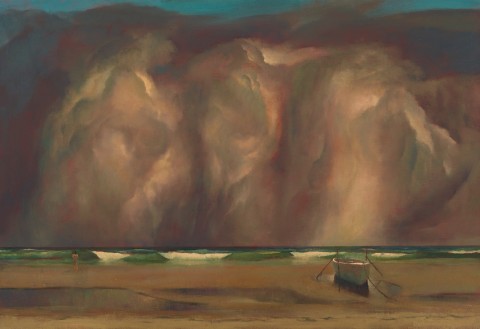THE CLOUDS, 2007
RICK AMOR
oil on canvas
89.0 x 130.0 cm
signed and dated lower left: RICK AMOR ’07
dated and inscribed with title verso: The Clouds / Sept / Oct / 07 / …
Liverpool Street Gallery, Sydney
Private collection, Queensland, acquired from the above in 2008
Rick Amor Paintings 2008, Liverpool Street Gallery, Sydney, 16 August – 11 September 2008, cat. 10 (illus. on exhibition catalogue cover)
‘I’ve always thought that what we see is not necessarily what’s there. There’s extra things we don’t see, there’s layers of reality ... The twentieth century seems to be a struggle to relate perception to reality …’1
A consummate painter, sculptor and printmaker with a highly successful career spanning four decades, Rick Amor is the master of transforming the ordinary into the extraordinary. Although drawing inspiration from the seemingly mundane, everyday sites of suburbia, his paintings are typically full of drama, deep melancholy and foreboding – resonating with a disquieting sense of both beauty and menace that alludes to the ambiguities inherent in life and humanity’s complex existence. Far from being literal translations, Amor’s urban landscapes have evolved, rather, over a number of years, and consequently reveal several layers of memory, knowledge and perception – together with the influence of literature concerning cities from T.S. Eliot’s poetic verse to the classic dystopian texts of George Orwell and Franz Kafka. As Paul McGillick observes of Amor’s work, ‘this is a phenomenological process by which the world as we think we see it is actually a construction based only partly on our understanding of it … there is a disconcerting quality to his pictures, as though they were not so much snapshots of reality as frozen frames from the moving pictures of our dreams’.2
Throughout his career, Amor has continuously depicted locations very familiar to him, with the most prominent arguably being the eastern shores of Port Phillip Bay near Frankston where he grew up. Although such beaches are generally placid and unspectacular in reality, Amor typically transforms them into works full of visual drama and narrative intensity, as encapsulated superbly by The Clouds, 2007. With its ominous bank of dark clouds, tempestuous waters and subdued tonal palette, the work is far removed from the idyllic interpretations of the same area by Arthur Streeton, Charles Conder or Penleigh Boyd, bearing stronger affinities with the dramatic seascapes of nineteenth-century English Romantic painters such as J.M.W. Turner and John Constable. A motif frequently punctuating Amor’s landscapes is that of the solitary individual, alone and dissociated in his or her environment, and the present composition is no exception – featuring a partially clad figure, their back turned to the viewer and carrying a child on their hip. As typical of Amor, there is enough narrative to make us wonder, but never enough to let us know: for example, why is the bather still on the desolate beach with a child at such a seemingly late hour with a turbulent storm brewing? Are they approaching the water for a swim, or just observing the dramatic denouement of a day at the beach? Like the best of Amor’s achievements, The Clouds evokes a palpable sense of mystery and eerie disquiet not dissimilar to that pervading the crime novels of which he is such an avid reader. Indeed, as Amor poignantly reflects, ‘I like to suggest that behind the prosaic reality something else is lurking’.3
1. The artist quoted in Catalano, G., Building a Picture: Interviews with Australian Artists, McGraw Hill, Melbourne, 1997, p. 141
2. McGillick, P., ‘The City as Dream - The New York Paintings of Rick Amor’, Monument, no.22, 1998, pp. 84 – 88
3. The artist quoted in Harford, S., ‘The Bronze Age of a City Seer’, The Age, Melbourne, 30 September 1994, p. 16
VERONICA ANGELATOS
